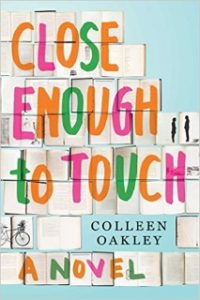How To Make Your Readers Believe the Unbelievable (Or, The Importance of Facts in Fiction)
By Guest | April 23, 2017 |
 Please welcome Colleen Oakley as our guest today! Colleen’s debut novel Before I Go was a People Best New Book Pick, an Us Weekly “Must” Pick, a Publisher’s Lunch Buzz Book, a Library Journal Big Fiction Debut, and an Indie Next List Pick. Formerly the senior editor of Marie Claire and editor-in-chief of Women’s Health & Fitness, Colleen’s articles, essays, and interviews have been featured in The New York Times, Ladies’ Home Journal, Marie Claire, Women’s Health, Redbook, Parade, and Martha Stewart Weddings. She lives in Atlanta with her husband, four kids, and the world’s biggest lapdog, Bailey. Close Enough to Touch is her second novel.
Please welcome Colleen Oakley as our guest today! Colleen’s debut novel Before I Go was a People Best New Book Pick, an Us Weekly “Must” Pick, a Publisher’s Lunch Buzz Book, a Library Journal Big Fiction Debut, and an Indie Next List Pick. Formerly the senior editor of Marie Claire and editor-in-chief of Women’s Health & Fitness, Colleen’s articles, essays, and interviews have been featured in The New York Times, Ladies’ Home Journal, Marie Claire, Women’s Health, Redbook, Parade, and Martha Stewart Weddings. She lives in Atlanta with her husband, four kids, and the world’s biggest lapdog, Bailey. Close Enough to Touch is her second novel.
People often ask me which I like better—writing articles for magazines or writing fiction, and I often say the two go hand in hand. Though fiction I’m obviously making up, I rely heavily on the research and reporting skills I honed in journalism to help guide and craft my novels. I think that surprises readers sometimes, so I’m passionate about sharing my process and the idea that the best fiction always has at least a small basis in fact.
Connect with Colleen on Facebook and Twitter.
How To Make Your Readers Believe the Unbelievable (Or, The Importance of Facts in Fiction)
Like most writers, I’ve always loved telling stories—the more outrageous, the better. As early as preschool, I remember making up the craziest things about my day to share with my mom when she would pick me up. Like the time I told her that the gingerbread man who I had been convinced lived in the little plastic house on the playground finally came out of hiding and chased us all around. Or the time I plucked a clover to bring home and when she asked about it, I told her the entire class had taken a field trip to a greenhouse and we got to pick out anything we wanted.
Fortunately instead of chastising me for what, in retrospect, appears to be a compulsive lying problem, my mom would just nod and go right along with whatever stories I was telling her. And I think, even more than the telling of the story, that’s got to be one of the most satisfying parts of writing fiction—when you’ve captivated the attention of your audience. I love when a reader tells me they completely bought into my story, that they were right there with my main character through every thought and feeling and couldn’t turn the pages fast enough to find out what happened next. But, it can also be one of the most challenging parts of writing fiction: how do you craft a believable story, especially if your story is based on an incredibly far-out premise?
 Fortunately, I’ve been honing that particular skill since, well, preschool, and these are a few of the things that I’ve found work for me.
Fortunately, I’ve been honing that particular skill since, well, preschool, and these are a few of the things that I’ve found work for me.
Do your research. Maybe it’s due to my background in journalism, but research is one of my favorite parts of crafting a novel. And I think it’s actually one of the most important parts. For fiction to be believable, it must have a basis in facts. For example, my latest book Close Enough to Touch is about a woman with a rare medical condition—she’s allergic to other humans. Now, I completely made it up; an allergy to humans doesn’t exist (I told you I like outrageous stories!), but I still needed to be knowledgeable about allergies and the science behind them, so I could convince readers that it was a real illness. I went deep into Google, learning as much as I could about both common and bizarre allergies and I interviewed a couple allergy experts at length, who helped me come up with the theoretical genetic cause of my main character’s affliction. Also, my nephew and niece both suffer from life-threatening food allergies, so I learned from watching what they have been through what it’s like to live day-to-day with a potentially fatal allergy.
Create realistic, relatable characters and focus on the emotions. If a reader can relate to your main character, literally anything can happen and they will suspend belief and go along for the ride. See: Harry Potter. The real key to this, though, is that the emotions have to ring true. We all know a school for wizards doesn’t exist, but if it did, how would it feel if you were told at the age of 11 that you had magical powers and were meant to go learn more about them? Amazing, terrifying, exciting. But if J.K. Rowling hadn’t captured the true awe that Harry Potter (or anyone) would feel upon hearing that news, the book would have fallen flat, instantly. Put yourself in your characters’ shoes and try to glean the truest, most human emotions and reactions that you can to whatever you’re putting them through. And not only do their emotions and reactions have to feel real, the characters themselves need to be three-dimensional, like your reader could sit down and have a conversation with them over coffee, which leads me to my next tip…
It’s all in the details. In high school, I lied to my mom (see? It’s really been a lifelong problem) and told her I was going bowling instead of to the party I knew she wouldn’t let me attend. Even back then, I knew I better have the details ready when I got home: what we ate, what my score was for the three games I didn’t bowl (and that it should be a low number and not 354, which a friend kindly informed me was not a possible score in bowling). And the same goes for fiction— the more specific details you can include in your story, the more a reader will buy into it. That’s why it’s important to know your characters— what do they eat for breakfast? What was their most embarrassing moment in life? What do they listen to on their way to work? Are they good drivers or have they had 14 speeding tickets? The same goes for setting— if an alien spaceship is going to land in the backyard of your protagonist’s house, that better be a realistic backyard. Let your reader see the azalea bush brilliantly blooming next to the ancient cement birdbath, smell the fresh-cut lawn that’s mostly weeds and clover (to the constant consternation of your main character), feel the warm sun beating down on their skin— that then gets blotted out by the silver domed aircraft silently drifting down from the sky.
Believe in yourself. Yes, this trite Hallmark saying applies here too, but I mean it in the most literal sense—convince yourself first, commit fully to your idea (no matter how bizarre or out there it may be) and forge ahead with confidence. Because if you don’t believe in the story you’re telling, you can guarantee your readers won’t either.
How do you make your readers believe the unbelievable?










Thank you for this. I’ve been both the story-creating kid and the adult hearing the stories from a child denying any knowledge of what happened to the candy in the Easter basket with chocolate smeared all over his cheeks. Readers desperately want to suspend their disbelief — and your perspective helps us ground ourselves before we go off into our flights of story weaving.
Thank you Louise!
My first novel was historical. I did tons of research and was told I made the past come alive. Research, then, as you said, is an essential part in expecting readers to suspend disbelief, to feel as if they are living in that period. Only one scene had a far-fetched element to it but by the time it came up it was so integrated into the story that you couldn’t extricate it without damaging the whole.
And I think that’s the key, at least for me. Make it so essential to the story, so necessary, that because the reader believes all the things that are factual and can be researched and proven, they trust you as a writer and easily come along for the part that isn’t fact, is pure fabrication.
I depend on that a lot in my current WIP. Trauma, hysterical amnesia and coma play essential roles in having readers believe my protagonist’s soul/spirit/mind, whatever you want to call it, has been thrown back into the past. Once the reader accepts those things that can be researched and proven, they will much more easily accept the things that can’t be proven because by then they want to believe them.
Great point! And your novels sound fascinating!
I’ve never had a problem with this in my stories, but I definitely agree with you that the key is making the characters believable. It’s all in the details. My characters are not perfect. Readers tune out and stop reading if they are. I know I do.
My characters stumbled, They weren’t perfect. They burned their breakfasts, had problems with family or authority figures. If you don’t provide the details, ones that people can relate to, the story you want to tell is usually DOA. Nobody’s going to hang around when the weirdness comes out, when they turn into werewolves or create whole worlds with a mere thoughts.
I started out writing fan fiction. Now some people here might turn their noses up at fan fiction, but I think its a great way to test the waters and see if you have the right stuff. Apparently I did. I had great success in that genre. I listened to the readers too. If they occasionally told me that a character seemed flat, or I got details wrong, then I fine tuned them in next story. It’s all in the details for sure.
Believing in yourself is another fine rule. If you don’t believe in yourself, nobody else will either.
As a kid I told the adults around me that our dog stole cookies at night. It helped that he looked very guilty when they asked him about it. Another time I tried to convince my mother that little people filled up the ice cube trays with milk and put them in the oven at night. They didn’t turn the oven on. That one didn’t work because my momma caught me in the act, but I tried.
But I never got in trouble for stealing those cookies, either.
Hilarious! Love that you were also a “story-telling” kid.
Hi Colleen! Oh, I love this topic. A couple tricks I’ve picked up along the way:
• Have a character express the doubts the reader might be feeling. Better to just get them out there! I did this in my debut, THE ART OF FALLING, when my character miraculously survived a 14-story fall.
• Consider making the unbelievable thing measurable in some way. I wrote a speculative story one time in which a chapter’s amputated leg regrew. No one believed the kid, said it was phantom pain, but each day he would measure his stump and it grew longer. Mark Danielewski used this technique in HOUSE OF LEAVES, where his house started to change in dimension.
And now I’m convinced, more than ever, that I need to move your books up in my TBR pile!
Kathryn, such great points! Love the express doubts tip— that is so true. And that spec story sounds amazing. What a fantastically weird concept!
I write most of my descriptive prose through the perceptions of the character observing it, so it is automatically believable, since that’s what they see. If they have trouble believing what they see, even that helps the reader relate to the character if they share the lack of belief. As the character comes to believe what he’s experiencing, so does the reader. Bear in mind I write SF/F/Weird, so believability is more elastic. I keep the details few (a common mistake in lying is to be too detailed about it). What the character cares about is what they will see, and they won’t care about the mundane details they deal with everyday, so I ignore those completely.
Good point— and yes with SF/F, I do think there’s a little more wiggle room. Thank you for commenting!
It is important to create a character a reader can relate to. The goal is to have them remember someone from their past or see a part of themselves in the character they read. It’s all about emotion and with that the reader will turn the page. When I’m reading a book it’s easy to spot a character that connected with the writer. The enthusiasm spills out into every page. Never put pen to paper unless these emotions exist.
Agreed! Emotional connection is so important— for the writer and the reader.
I recently read “Before the Fall” by Noah Hawley. In the beginning, the protagonist survives the crash of a small plane several miles off the coast of Martha’s Vineyard. A 4-year old boy is the only other survivor and our protagonist manages to swim for 8 hours, with a busted shoulder, while holding onto the 4 year old. They make it to land and are safe. As I write this, even I want to roll my eyes, but I bought into every second of the drama because of the backstory of him being a swimmer, the description of the angry ocean, the wreckage, (This is really happening!) and his constant “self talk” convincing him he could save himself and the boy. It was only after the fact, that I had the conscious thought about the impossibility of it all. Well done, Mr. Hawley. Well done.
Yes! I read that too and agree completely. What a scene— and I was in it 100 percent.
I’ve always told my writing students that readers will accept the “one big lie,” but everything else must be rooted in reality.
For the Harry Potter series, the one big lie is that magic is real.
Beyond that one lie, readers will find it harder and harder to believe in the story, and many will exit the story at the second or third until you are left with almost no readers.
I’ve never thought of it that way, but it makes a lot of sense. Thank you so much!
What? The four-leaf clover wasn’t a special present from the gingerbread man, running out of his little plastic house to thrust it into your hand before you got away? Now that’s a story I would believe 100%!
Ha!! :)
I confess to being a research junkie. I’ll dig deep into history and background way beyond anything I might “need” to know for a story. But sometimes I’ll come across something that’s not only interesting for detail or authenticity, but that advances the plot or adds suspense. For instance I learned that a statue of St. Francis in a St. Louis city park was commissioned by the widow of a locally famous playboy who drowned in a New Year’s Day swim in the Mississippi. My MC was contemplating both suicide and returning to her home to New Orleans. The playboy’s story provided foreshadowing and irony.
Yes- that’s wonderful when that happens! I just worked out a twist in my current WIP based on a nugget of research I uncovered as well. Thank you for commenting!
Such a great article! Thanks for featuring Colleen as part of her TLC Book Tour!